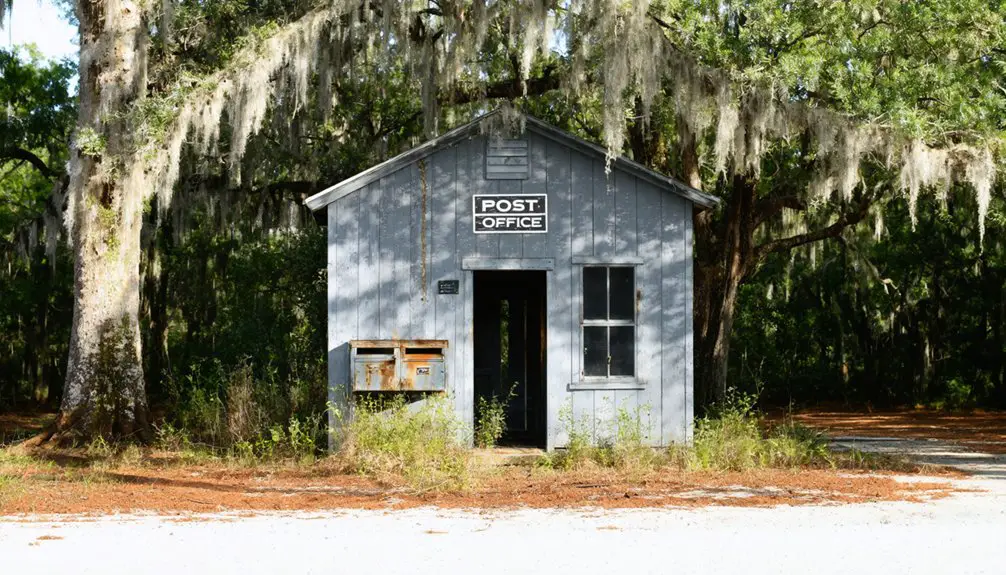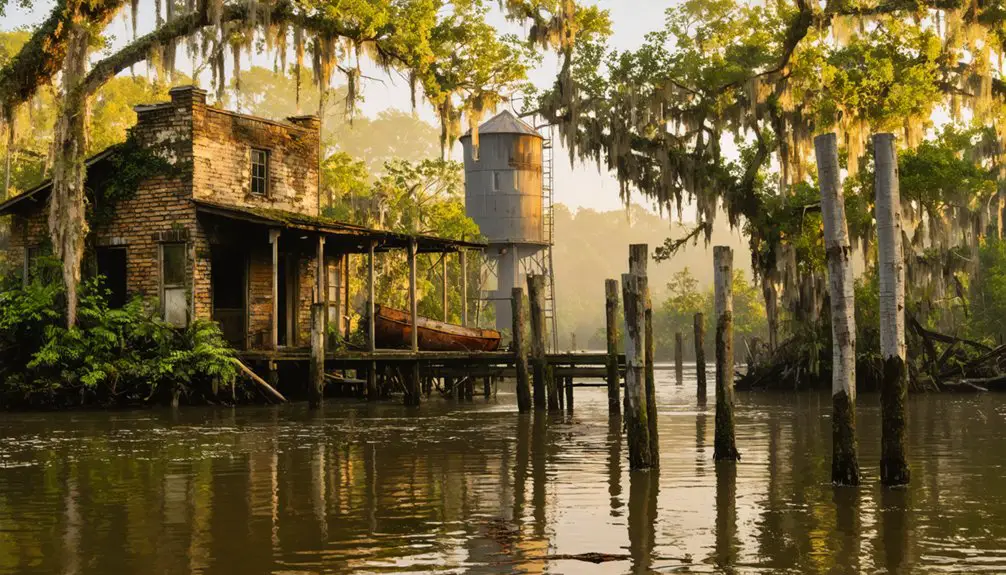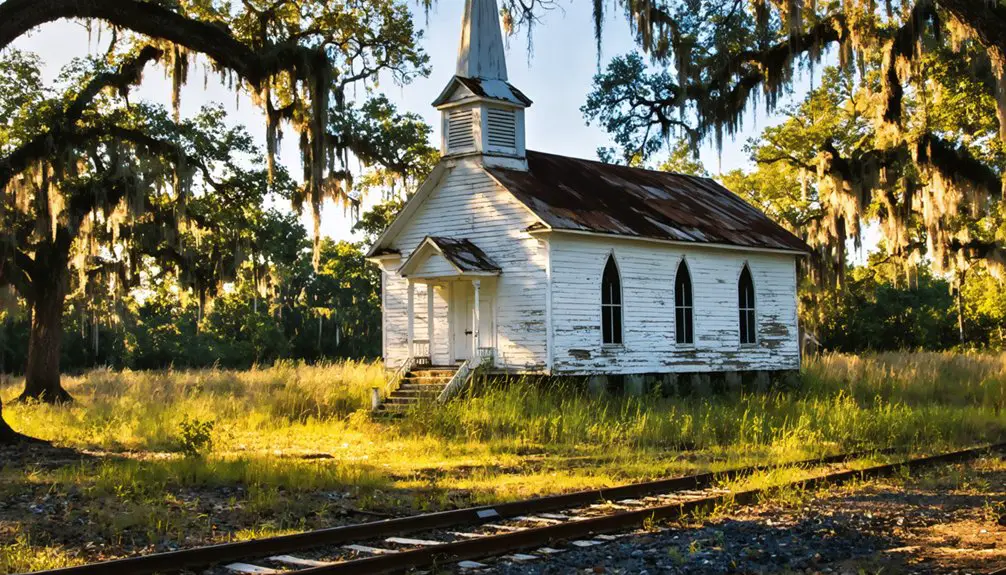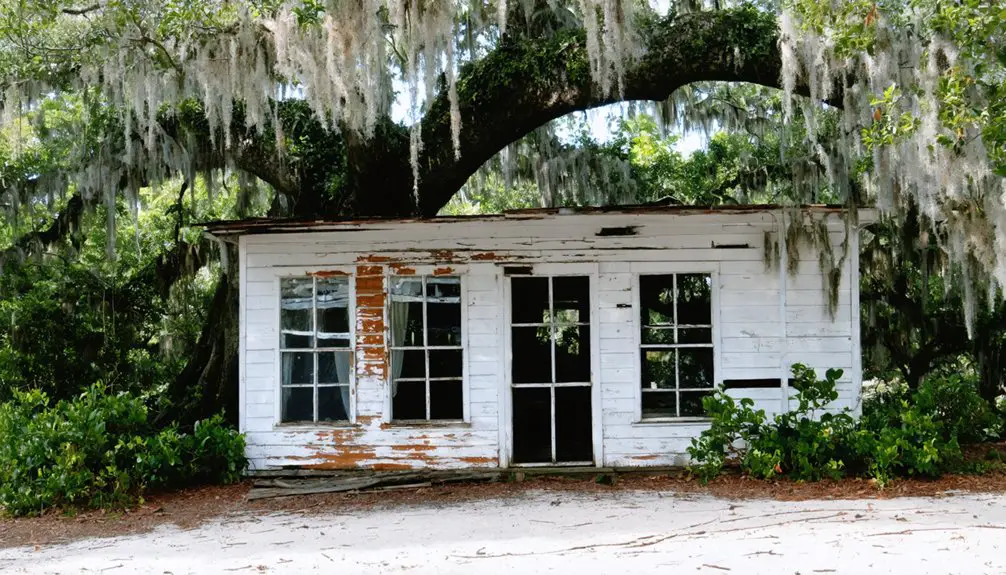You’ll find Gaiter, Florida west of Ocala at coordinates 29.0085, -82.3433, a ghost town that thrived from 1889 to 1928. This former riverside settlement centered around its post office, Cedar Grove Methodist Church, and the Withlacoochee River’s commerce. While economic challenges and the Great Depression led to its decline, you can still visit the preserved church and cemetery today. The site’s scattered ruins hold countless stories of pioneer life in Marion County.
Key Takeaways
- Gaiter was established in 1889 with a post office west of Ocala, Florida, at coordinates 29.0085, -82.3433.
- The community thrived on turpentine production and river commerce before economic decline in the early 20th century.
- Closure of the post office in 1928 marked a significant turning point in Gaiter’s transformation into a ghost town.
- The Great Depression accelerated Gaiter’s abandonment, though Cedar Grove Methodist Church remains as a historical landmark.
- Environmental challenges, including the 1894-1895 “Big Freeze” and Withlacoochee River flooding, contributed to the town’s decline.
Origins of a Withlacoochee River Settlement
While many Florida ghost towns fade into obscurity, Gaiter’s origins along the Withlacoochee River highlight the strategic importance of waterways in 19th-century settlement patterns.
You’ll find this Marion County settlement positioned west of Ocala at coordinates 29.0085, -82.3433, where pioneers recognized the river’s potential for sustaining life and commerce.
The Withlacoochee settlement took formal shape in 1889 when Gaiter established its post office, though the area’s development was already underway as part of a broader network including Cedar Grove and Camp Izard.
Near the settlement stood the historic Cedar Grove Church, which served as a spiritual center for the community before burning down.
You can trace Gaiter’s origins to the practical needs of early settlers who relied on the river’s resources – from transportation routes to fishing – while the surrounding pine forests provided timber for construction and trade. The community’s economic foundation was strengthened by the thriving turpentine production industry.
The Cedar Grove Connection
Cedar Grove’s merger with Gaiter exemplified how Florida’s river settlements often grew through community integration rather than isolation.
You’ll find Cedar Grove’s significance deeply woven into the fabric of Gaiter’s development, with landmarks like the Cedar Grove Methodist Church and Pine Level School becoming central to the expanded community’s identity.
The church, built before 1880 and rebuilt in 1936 after a fire, served as both a spiritual center and schoolhouse. The original post office operated from 1889 to 1928, marking an era of growth and stability. Community event traditions flourished here, from local fairs to religious gatherings that strengthened social bonds.
Across Route 200, a bustling turpentine operation drove the local economy, while agricultural cooperation between settlements guaranteed mutual prosperity. Located one mile north of the Withlacoochee River, the cemetery became a testament to the area’s enduring heritage.
This integration created a vibrant regional community where shared resources and social connections helped residents thrive along the Withlacoochee River.
Life Around the Post Office (1889-1928)

If you’d visited Gaiter’s post office between 1889 and 1928, you’d have found it serving as both a mail distribution center and the heart of local community life.
Farmers and ranchers would gather at the post office to collect their mail, exchange news, and conduct business transactions through postal services.
The postmaster’s counter buzzed with activity as residents picked up mail-order supplies, posted correspondence, and caught up on the latest developments from neighboring towns.
Daily Mail Operations
The Gaiter post office served as the central hub of communication from 1889 to 1928, managing daily mail operations for the rural Florida community.
You’d find the postmaster manually sorting incoming letters and packages from regional centers, while coordinating outbound mail routines through horse and foot carriers. Similar to offices like Aberdeen in 1889, Gaiter’s opening marked a period of postal expansion across Florida’s developing regions. The delivery challenges included maintaining reliable routes across rural terrain and adhering to railroad schedules that connected Gaiter to larger Florida towns.
Inside the post office, staff used hand-stamps and cancellation devices to process mail, keeping detailed records in ledger books.
They’d organize correspondence in secure mail sacks and locked boxes, while managing the sale of stamps and money orders. The facility’s daily operations proved essential for local commerce, agriculture, and social connections until changing demographics led to its closure.
Community Hub Activities
Beyond its mail-processing duties, Gaiter’s post office emerged as a vibrant social cornerstone where daily community life flourished between 1889 and 1928. You’d find farmers, ranchers, and citrus growers coordinating their activities while catching up on local news.
Postal traditions centered around regular mail delivery times, which structured the community’s daily rhythm and reduced isolation for rural inhabitants.
As a dynamic hub, the post office facilitated community gatherings ranging from informal discussions to seasonal events like harvest festivals. You’d witness the exchange of agricultural information, government notices, and homesteading updates.
The space often shared quarters with general stores, creating a multifaceted center where you could handle business transactions, collect supplies, and participate in local governance discussions all in one location.
Pioneer Families and Community Bonds
You’ll find the pioneer families of Gaiter, originally known as Cedar Grove, formed tightly interwoven settlement patterns across Marion County’s rural landscape in the 1800s.
The Drake family, along with other early settlers, established vital community infrastructure including the post office while maintaining close relationships with neighboring settlements like Camp Izard and Stokes Ferry. Like many Florida ghost towns, Gaiter’s decline came during the Great Depression when families were forced to seek opportunities elsewhere.
These pioneer families created robust social support networks through shared religious life at Cedar Grove Methodist Church, communal economic ventures in turpentine production, and mutual aid systems that proved essential for survival in the isolated frontier setting. The cemetery, which contains gravestones from 1856, stands as a testament to these early community bonds.
Early Family Settlements
During the 1870s, pioneering families like the Drakes established deep roots in Gaiter, Florida, creating a tightly interconnected community that would flourish for generations. Like the early Spanish Main settlers, these families developed a self-sufficient economy based on local resources and trade networks.
These early settlers preserved their pioneer heritage through agricultural pursuits, turpentine production, and collective support networks. Despite settlement challenges, families from Gaiter, Cedar Grove, Camp Izard, and Stokes Ferry formed a resilient regional community rather than remaining isolated outposts.
- The 1889 establishment of Gaiter’s post office served as a crucial communication hub, connecting pioneer families for nearly four decades.
- Family-operated enterprises, from ranching to turpentine production, sustained the community’s economic independence.
- Cedar Grove Methodist Church and Pine Level School anchored the social fabric, uniting families through worship and education.
Social Support Networks
While early settlers faced intimidating challenges in Florida’s frontier, the interconnected communities of Gaiter, Cedar Grove, Camp Izard, and Stokes Ferry developed robust social support networks that proved essential to their survival and prosperity.
You’ll find that these communities maintained strong bonds through religious gatherings at Cedar Grove Methodist Church and social events like the Camp Izard Annual Picnic of 1897. Similar to how Spanish settlements first established community networks in the 1500s, these towns fostered close relationships between residents.
The region’s cultural continuity thrived as families collaborated on labor-intensive tasks, from logging to turpentine production. Multi-generational households formed extensive kinship networks, creating resilient support systems that extended beyond blood relations. Much like the peak of 600 residents who once populated Fort Dade, these tight-knit communities relied on each other for daily survival and social interaction.
These community connections weren’t just social – they formed the backbone of economic cooperation, with shared resources and knowledge helping pioneer families weather hardships and isolation together.
River Commerce and Local Economy

As Florida’s river systems formed the backbone of 19th-century commerce, Gaiter’s economic significance depended heavily on its waterway connections.
You’ll find that river transportation linked the town to crucial trade networks, connecting settlements like Cedar Grove and Stokes Ferry. The waterways served as lifelines for the region’s thriving turpentine industry, allowing producers to ship their goods efficiently to market.
- The inland water routes reduced dangerous coastal navigation by nearly 1,000 miles, creating safer and more profitable trade opportunities.
- Economic interdependence between communities flourished through waterborne commerce, fostering shared prosperity.
- Local industries, particularly turpentine production near Route 200, relied extensively on river access to sustain their operations.
This integrated network of river commerce shaped Gaiter’s development until early 20th-century transportation shifts began transforming the region.
Sacred Grounds: The Church and Cemetery
As you walk through Cedar Grove Cemetery, you’ll find weathered tombstones dating back to the 1800s that chronicle the lives of Gaiter’s founding families.
The sacred burial ground continues to draw visitors who leave offerings at the gate, honoring ancestral traditions and maintaining spiritual connections.
This final resting place, nestled beside the historic Cedar Grove Church, serves as one of the last physical reminders of the once-thriving Gaiter community.
Weathered Markers Tell Stories
Time-worn gravestones and memorials at Cedar Grove Methodist Church and Cemetery reveal poignant stories of Gaiter’s former residents.
You’ll find weathered inscriptions that speak of military service, family bonds, and spiritual devotion. The markers, some crumbling and others partially unreadable, stand as silent witnesses to forgotten stories of this once-thriving community west of Ocala.
- Military markers honor those who served, with rank symbols preserving their sacrifices
- Personal items like beads and crosses left at graves show ongoing connections to the past
- Hand-carved stones reflect local craftsmanship and the resourcefulness of early settlers
The cemetery’s markers, positioned at 29.0085, -82.3433, offer you glimpses into 19th and early 20th-century life, from founding families to the socioeconomic diversity that shaped this turpentine town’s identity.
Sacred Burial Ground Traditions
Beyond individual markers lie deeper spiritual traditions at Cedar Grove Methodist Church and Cemetery, where sacred burial customs shaped the community’s relationship with death and remembrance.
You’ll find Methodist burial customs reflected in the layout, with family plots grouped together to maintain bonds even in death. The cemetery’s post and wire fencing marks clear boundaries between secular and sacred sites.
These hallowed grounds weren’t just for burial – they served as gathering places where the living honored their ancestors through periodic memorial services.
When fire destroyed the original church in 1935, the community’s dedication to preserving these sacred spaces led them to rebuild within a year, demonstrating their commitment to maintaining spiritual continuity across generations.
Community’s Final Resting Place
Standing as the last physical remnant of Gaiter’s community life, Cedar Grove Methodist Church and Cemetery offer a poignant glimpse into Florida’s vanished settlements.
You’ll find this sacred space near the Halpata Tastanaki Preserve, where the 1936 rebuilt church and its adjoining cemetery continue to tell the story of a once-thriving rural community.
The historical reverence is evident in the offerings left at the cemetery gate and the well-preserved 19th and early 20th-century gravestones that mark the final resting places of Gaiter’s founding families.
- The site’s community significance endures through its role as a genealogical treasure trove for researchers and descendants
- An old hand pump well stands as a symbol to daily life in this former settlement
- The natural seclusion of the grounds creates an atmosphere of reflection and connection to the past
Decline of a Riverside Community
While Gaiter once thrived as a bustling riverside community centered around turpentine production, its decline began in the early 20th century due to a confluence of economic and environmental factors.
The town’s economic resilience weakened as its turpentine industry collapsed from depleted pine forests and shifting market demands.
You’ll find that environmental challenges, including periodic flooding from the Withlacoochee River and the devastating “Big Freeze” of 1894-1895, further strained local agriculture and infrastructure.
The closure of Gaiter’s post office in 1928 marked a turning point, followed by younger residents leaving for urban opportunities.
When railroads and transportation routes bypassed the town, its isolation deepened.
The Great Depression delivered the final blow, accelerating the community’s transformation into the ghost town you’d find today.
Preserved Structures and Historical Landmarks

Despite Gaiter’s decline into a ghost town, several significant structures and landmarks remain as monuments to its vibrant past.
You’ll find the Cedar Grove Methodist Church, rebuilt in 1936 after a fire, standing proudly alongside its adjacent cemetery. The preserved church and burial ground demonstrate remarkable community resilience, while the old hand pump well offers a tangible connection to daily life.
Though the turpentine still site has been transformed into modern development, the surrounding protected preserve lands guarantee historical preservation of these remaining landmarks.
- The church-cemetery complex serves as a spiritual anchor, telling stories of the community’s determination to maintain their heritage.
- Protected preserve lands shield these historical sites from development, safeguarding their authenticity.
- Each preserved structure provides researchers and visitors with invaluable insights into early Florida settlement patterns.
Finding Gaiter Today: A Hidden Time Capsule
The ghost town of Gaiter beckons history enthusiasts to its peaceful location along the Withlacoochee River in Marion County, Florida.
You’ll find this hidden time capsule west of Ocala at coordinates 29.00854, -82.34334, nestled within a protected hunting preserve off Route 200.
Your ghost town exploration centers around the Cedar Grove Methodist Church and Cemetery at 13525 SW 147th Lane, Dunnellon.
While most original structures have vanished, the church, rebuilt in 1936, and an old hand pump well remain as evidence to Gaiter’s past.
Historical preservation efforts through the hunting preserve have maintained these landmarks, though you’ll need to navigate carefully as signage is limited.
The natural Florida landscape and riverine environment create a serene backdrop, transforming your visit into an intimate journey through time.
Legacy of Marion County’s Lost Settlement

Once a vibrant part of Marion County’s rural landscape, Gaiter’s legacy endures through its interconnected history with Cedar Grove, Camp Izard, and Stokes Ferry.
While this ghost town has faded from view, its historical significance lives on through the Cedar Grove Methodist Church and cemetery, which stand as silent witnesses to the area’s past.
The turpentine industry that once drove the local economy has given way to modern development, marking the evolution of this rural community.
Like many rural Florida settlements, Gaiter’s turpentine-driven past has faded into history, replaced by the steady march of progress.
- The preservation of Cedar Grove Cemetery connects you to the original settlers’ stories and sacrifices
- You’ll find evidence of the community’s spiritual foundation in the rebuilt 1935 Methodist Church
- The transformation from turpentine production to contemporary developments shows you how rural Florida communities adapt and change
Frequently Asked Questions
Were There Any Notable Crimes or Disputes in Gaiter’s History?
You won’t find documented crime incidents or historical disputes in available records, though fires impacted the area – most importantly destroying the original Cedar Grove Church before its 1930s rebuilding.
What Were the Primary Causes of Death Among Gaiter’s Residents?
With disease claiming up to 40% of children before age 5, you’d face deadly health epidemics, environmental hazards from turpentine work, malaria from swamps, and tuberculosis spreading through cramped living spaces.
Did Native American Tribes Interact With the Gaiter Settlement?
You won’t find documented evidence of significant tribal relations or cultural exchanges between Native Americans and Gaiter’s settlers, though indigenous peoples inhabited the broader region before the town’s establishment.
What Was the Average Property Value in Gaiter During Its Peak?
Like a fading photograph, precise property values are lost to time. You’d likely have found homes ranging from hundreds to thousands of dollars, following economic trends of similar rural Florida towns.
Did Any Famous Personalities or Politicians Ever Visit Gaiter?
You won’t find any historic visitors or celebrity sightings in Gaiter’s records. There’s no documented evidence of famous politicians or notable personalities ever visiting this rural community during its existence.
References
- https://travelmadepersonal.com/gaiter-ghost-town-florida/
- https://www.youtube.com/watch?v=uhbgYxjs7Ss
- https://www.youtube.com/watch?v=nRR0vaI94vQ
- https://en.wikipedia.org/wiki/List_of_ghost_towns_in_Florida
- https://www.ghosttowns.com/states/fl/gaiter.html
- https://travelmadepersonal.com/juliette-ghost-town-florida/
- https://www.interment.net/data/us/fl/marion/cedar_grove.htm
- http://www.fphsonline.com/jrnlpdf/journal23.2.pdf
- http://www.fphsonline.com/jrnlpdf/journal19.2.pdf
- http://www.fphsonline.com/docs/FPHJ Index 1993-2021 po-pm-pm rev.pdf



